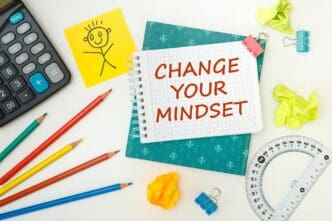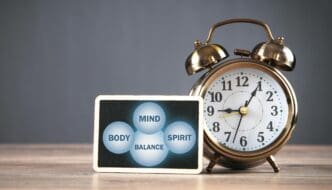A vision board, a curated collage of images and words representing one’s goals, is a powerful tool for improving mental and emotional well-being. Anyone seeking to move beyond vague desires for happiness and toward specific, actionable mental health objectives can create one. By making abstract goals tangible, this practice leverages established psychological principles like goal-setting theory and cognitive priming to serve as a daily, visual reminder of one’s desired emotional state. Created either physically with a corkboard and magazines or digitally with apps like Pinterest, a vision board becomes an effective guide when placed in a highly visible location, helping to focus the mind and inspire the small, consistent actions that foster lasting positive change.
What is a Vision Board? Beyond the “Law of Attraction”
At its core, a vision board is a simple concept: a physical or digital collage of images, quotes, and affirmations that represent your aspirations. While often associated with the “law of attraction”—the belief that positive thoughts bring positive experiences—its true power lies in well-established psychological mechanisms. It’s less about magical thinking and more about mindful intention-setting.
Think of it as a tangible map for your brain. By externalizing your internal desires, you give them form and clarity. This process transforms abstract hopes into concrete, visible targets, making them feel more achievable and real.
The Psychology Behind the Board
The effectiveness of a vision board isn’t mystical; it’s grounded in how our brains process information and motivate behavior. One key principle is Goal-Setting Theory, which posits that specific and challenging goals lead to higher performance than vague or easy ones. A vision board forces you to define exactly what “feeling calm” or “being more connected” looks like to you.
The tool also utilizes a psychological phenomenon known as priming. Repeated exposure to certain stimuli—like the images of peace, strength, or joy on your board—can unconsciously influence your subsequent thoughts and actions. Seeing a picture representing tranquility each morning can prime your brain to seek out and create moments of calm throughout your day.
Furthermore, this practice engages the brain’s Reticular Activating System (RAS), a network of neurons that acts as a filter for information. When you decide something is important, like your mental health goals, the RAS begins to pay more attention to information and opportunities related to it. Your vision board essentially programs your RAS to be on the lookout for people, resources, and situations that align with your well-being objectives.
Step 1: The Foundation – Clarifying Your Mental Health Goals
The most critical step in creating an effective vision board has nothing to do with scissors or glue. It is the deep, internal work of self-reflection. Without this foundation, a vision board is just a pretty craft project. You must first understand what you truly want to cultivate in your mental and emotional life.
From Vague Wishes to Specific Intentions
Many of us start with broad statements like, “I just want to be happy.” A vision board challenges you to go deeper. What does happiness feel like in your body? What does it look like in your daily life? The goal is to translate these big concepts into specific, feeling-based intentions.
For example, instead of “less anxiety,” your intention might be, “I want to feel grounded and centered during stressful situations.” Instead of “be healthier,” it could be, “I want to feel energetic and honor my body with rest and nourishment.”
Journaling Prompts for Self-Reflection
To help clarify your intentions, set aside quiet time with a journal and consider these questions. Don’t rush the answers; let them emerge honestly.
- How do I want to feel when I wake up each morning? (e.g., peaceful, motivated, rested, optimistic)
- What negative thought patterns or self-talk do I want to release? What positive, compassionate voice do I want to cultivate instead?
- What does a healthy and loving relationship with myself look like?
- What activities, places, or people bring me a sense of genuine joy, calm, or connection?
- What does “feeling safe” mean to me, both physically and emotionally?
- What boundaries do I need to set to protect my energy and peace?
Focus on Feelings, Not Just Things
A common mistake is to fill a vision board with material possessions. While those can be goals, a mental health vision board should prioritize feelings. A picture of an expensive car might represent freedom, but an image of an open road or a soaring bird might capture that feeling more authentically.
When you look for images, ask yourself: “How does this image make me feel?” The goal is to find visual representations of your desired emotional states. A picture of a serene lake isn’t about owning a lake house; it’s about invoking the feeling of serenity you wish to experience more often.
Step 2: Gathering Your Materials and Creating Your Collage
Once you have a clear sense of your core intentions, you can begin the fun, creative part of the process. This stage is an act of mindfulness in itself—a chance to play and connect with your goals in a tactile way.
Physical vs. Digital Boards
You have two main options for your board, each with its own benefits. A physical board might use a corkboard, poster board, or canvas as a base. You’ll need scissors, glue or pins, and source materials like magazines, newspapers, printed photos, and postcards. The main advantage is its tangible, constant presence in your space.
A digital board can be created using platforms like Pinterest, Canva, or a dedicated vision board app. You can easily gather images from across the internet and arrange them in a collage. The benefits are flexibility—it’s easy to edit—and accessibility, as you can set it as your phone or computer wallpaper.
Finding the Right Imagery and Words
Begin gathering materials that resonate with the feelings you identified in your journaling. Look for images, colors, textures, and words. Don’t limit yourself. If a particular color feels calming or a specific word feels powerful, include it.
Good sources include nature magazines, travel brochures, wellness blogs, and art websites like Unsplash or Pexels for high-quality, free images. Print out quotes that inspire you or write affirmations in your own handwriting for a personal touch.
The Assembly Process: An Act of Mindfulness
Treat the creation of your board as a special ritual. Set aside an hour or two, put on some calming music, light a candle, and eliminate distractions. Lay out all your gathered materials and begin arranging them on your board.
Trust your intuition. Don’t overthink the placement of each item. Let your gut guide you to what feels right. You might group images by theme—one corner for calm, another for connection—or you might create a more integrated, flowing collage. There is no right or wrong way to design it, as long as the final result feels inspiring and authentic to you.
Step 3: Activating Your Vision Board
A vision board’s power diminishes if it’s created and then forgotten. To make it an effective tool for change, you must integrate it into your daily life. This is where vision meets action.
Strategic Placement
Where you put your board matters immensely. It needs to be somewhere you will see it every single day, multiple times. Excellent locations include next to your bed (so it’s the first and last thing you see), in your home office across from your desk, or on the back of your front door.
If you made a digital board, set it as the lock screen on your phone and the desktop background on your computer. The key is frequent, effortless visibility.
Engaging With Your Board Daily
Looking at your board should be an active, not a passive, experience. Take 1-2 minutes each day—perhaps in the morning or before bed—to truly connect with it. Look at each image and allow yourself to feel the emotion it represents.
Use it as a prompt for a short visualization exercise. For an image representing peace, close your eyes and imagine that feeling of peace washing over you. This practice reinforces the neural pathways associated with these desired states, making them more accessible over time.
From Vision to Action: Setting Micro-Goals
The board is your “why,” but you still need to create the “how.” The final, crucial step is to use your board as inspiration for small, concrete actions. Look at a theme on your board and ask, “What is one small thing I can do today or this week to bring this feeling to life?”
If your board has images representing self-compassion, a micro-goal might be to challenge one piece of negative self-talk this week. If it has a picture representing joyful movement, a micro-goal could be to put on music and dance for five minutes. These small, consistent actions are what build momentum and create real, lasting change.
Common Pitfalls and How to Avoid Them
While a powerful tool, a vision board can be misused. Being aware of common pitfalls ensures it remains a source of support, not stress.
The Comparison Trap
Be mindful of where you source your images, especially from social media. Using hyper-curated, unrealistic images of other people’s lives can trigger feelings of comparison and inadequacy. Your board should be a reflection of your authentic desires, not a recreation of someone else’s highlight reel.
When to Update Your Board
Your vision board is a living document, not a static monument. As you grow and evolve, so will your goals and priorities. Plan to formally revisit your board every six to twelve months, or anytime you feel a significant life shift. It’s perfectly fine to remove things that no longer resonate and add new images that reflect your current aspirations.
A Tool, Not a Magic Wand
Finally, it is essential to hold a balanced perspective. A vision board is a powerful psychological tool that can clarify intent, boost motivation, and focus the mind. However, it is a supplement to, not a replacement for, professional mental health care. If you are struggling with significant mental health challenges, a vision board can support your journey, but it should be used in conjunction with therapy, counseling, or medical treatment as recommended by a healthcare professional.
Ultimately, creating a vision board for your mental health is a profound act of self-care. It is a declaration that your emotional well-being matters. By translating your inner world into a visible guide, you empower yourself to consciously and consistently take the small steps that lead to a more peaceful, resilient, and joyful life.






